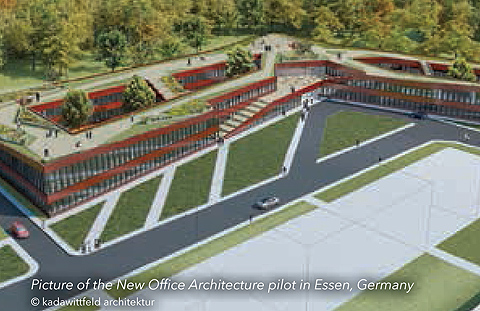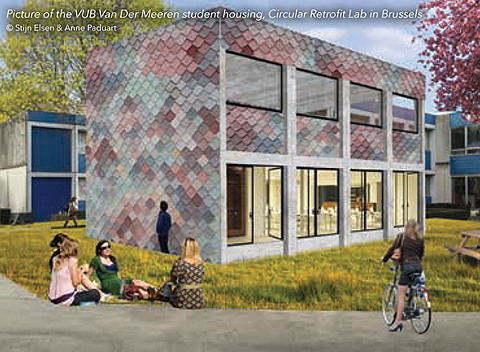The EU funded BAMB project, Buildings As Material Banks, brings 15 partners from 7 European countries together for one mission – enabling a systemic shift in the building sector by creating circular solutions (see fi rst presentation of the project in EEI of Summer 2016).
The project is developing and integrating tools that will enable the shift: Materials Passports and Reversible Building Design – supported by new business models, policy propositions and management and decision-making models. During the course of the project these new approaches will be demonstrated and refi ned with input from 6 pilots.
The BAMB project started in September 2015 as an innovation action within the EU funded Horizon 2020 program. A great deal of progress has already been made and rich exchanges have taken place with stakeholders via the BAMB Stakeholder Network and Special Interest Groups, now counting approximately 275 members. In additional to topic specifi c workshops, the Annual Meeting of the BAMB Stakeholder Network was held on the 24th of January in Brussels. Interactions and input from stakeholders has contributed to shape the development of tools within the project.
MATERIALS PASSPORTS
Important steps have been taken towards achieving the use of Materials Passports. Following the completion of a user requirements analysis, a Software Platform has been developed to support the generation of, and access to Materials Passports. The vision for Materials Passports has also been described as part of the Framework for Materials Passports, which serves as a tool to explain passports and give them additional context. Initial steps to begin generating 300 passports within the project have also been taken, testing and refi ning the platform and framework in the process.
TOOLS FOR REVERSIBLE BUILDING DESIGN
Additional technical developments have occurred in the area of reversible building design. Signifi cant steps have been taken in the development of the Re-use Potential Tool, which will enable the assessment of building structures’ reuse potential - at the system and component level - in order to preserve buildings’ and their components’ and materials’ residual value, fostering high quality reuse. The tool is to be used by a variety of actors interested in the construction of buildings as materials banks - system and product developers, architect and engineering offi ces, demolition contractors, building owners and investors. In addition to providing a score for reuse potential varying from high level reuse (100% reuse) to low level reuse (10%), the tool will also address information about disassembly characteristics of building structures.
 PUTTING TOOLS TO THE TEST IN BAMB PILOT PROJECTS
PUTTING TOOLS TO THE TEST IN BAMB PILOT PROJECTS
New tools developed as part of the BAMB project are being put to the test over the course of the project by way of testing in 6 real-scale construction and renovation pilots. All pilots have begun to perform a feasibility study in which the objectives of the actions regarding Material Passports and reversible building design are being studied on a theoretical level.
The different scenarios and choices will be described. An analysis of all construction aspects needed to implement these objectives will be made. This study will be used as a basis for the prototyping and the construction of the pilots, since it will be developed and used as the construction dossier. The study is to be completed in the summer of 2017.
POLICIES TO SUPPORT A CIRCULAR CONSTRUCTION INDUSTRY
To facilitate future applications and exploitation of BAMB results, recommendations for policies and standards will be developed later in the project. Progress already made includes mapping existing policies, standards and regulations in 4 European countries as well as at the EU level, and the writing of a report which summarizes the effect of the identifi ed mechanisms on the transition towards a circular construction industry. This report has been discussed with stakeholders in a Special Interest Group workshop in order to confi rm initial conclusions, as well as to begin identifying best practices around the globe to further inspire future recommendations. Currently exploration of best practices and an impact assessment of existing policies is under way to identify success factors to be applied to future policy suggestions.
 DEVELOPING A SHARED VISION FOR THE FUTURE
DEVELOPING A SHARED VISION FOR THE FUTURE
The BAMB partners aim to tackle systemic barriers. Motivating the work done towards achieving technical and policy solutions, the Consortium is collectively identifying and investigating the barriers and opportunities of the current system, while developing a shared vision and blueprint for a future system confi guration. The Synthesis of the State of the Art Report is now available for download on the BAMB website. This report, Key barriers and opportunities for Materials Passports and Reversible Building Design in the current system, is a snapshot of the current system as perceived within the BAMB Consortium. Key questions addressed include: Why are design/build for change and circular economy not yet (fully) integrated in the current building practice and related policy? and What are the main barriers and opportunities within the current system for implementing Materials Passports and reversible building design protocols? Go to www.bamb2020.eu/topics/overview/state-of-the-art for the whole report.
More information:
Web: www.BAMB2020.eu
linkedin.com/bamb2020facebook.com/bamb2020
twitter.com/bamb2020
Email: info@bamb2020.eu
The BAMB consortium consists of: Brussels Environment (IBGE-BIM, LEAD PARTNER) - Environmental Protection Encouragement Agency (EPEA) - Vrije Universiteit Brussels (VUB) - Vlaamse Instelling voor Technologisch Onderzoek (VITO) - Building Research Establishment (BRE) - Zuyd Hogeschool - IBM Netherlands - Sunda Hus i Linköping AB - Ronneby Municipality - Technische Universiteit München (TUM) - Universiteit Twente - Universidade do Minho - Sarajevo Green Design Foundation - Drees & Sommer - BAM Construct UK